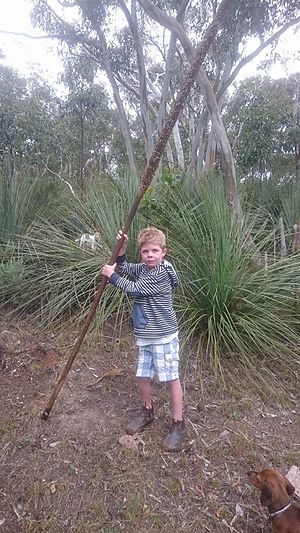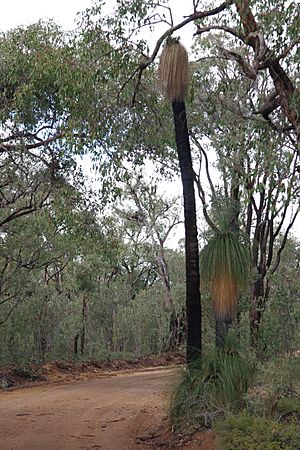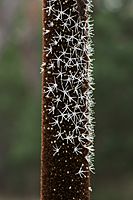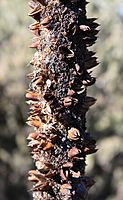Xanthorrhoea facts for kids
Quick facts for kids Xanthorrhoea |
|
|---|---|
 |
|
| X. semiplana | |
| Scientific classification | |
| Species | |
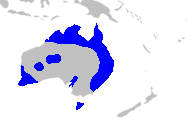 |
|
| Distribution of Xanthorrhoea | |
| Synonyms | |
|
Acoroides Sol. ex Kite, not validly published |
Xanthorrhoea is a group of about 30 different types of flowering plants. These plants are special because they only grow in Australia. They are often called grasstrees.
Contents
What Grasstrees Look Like
All grasstrees are perennials, meaning they live for many years. They have a special way of growing thicker stems. Many, but not all, kinds of grasstrees grow a stem above the ground. This stem can take up to 20 years to appear!
Young grasstrees start as a bunch of stiff, grass-like leaves. Slowly, a thick stem grows underneath. This stem is rough because it's covered in old leaf bases. The main stem might grow straight up, or it might branch out. Some species branch if their top growing part is hurt. Others naturally grow many branches.
Grasstrees grow a very long flower spike. This spike grows above a bare part called a scape. The whole thing can be over four metres long in some types! Grasstrees flower during a specific time, which is different for each species. Often, bushfires help them flower. Fires burn the leaves and blacken the trunk. But the tree survives because the dead leaves around the stem protect it from the heat.
Grasstrees grow very slowly. People often say they grow about 2.5 cm (1 inch) per year. But this isn't always true. After they first start growing, their speed changes a lot depending on the species. A five-metre-tall grasstree of a fast-growing kind might be 200 years old. But a five-metre-tall tree of a slow-growing kind could be 600 years old!
Naming Grasstrees
Xanthorrhoea is part of the plant family called Asphodelaceae. These plants are monocots, which means their seeds have one leaf. They belong to a larger group called Asparagales.
The name Xanthorrhoea comes from Ancient Greek. It means "yellow flow." This refers to the yellow resin that comes from the plant. Smith named it in 1798. He used the Greek words xanthos (yellow, golden) and rhoea (flowing, flow).
Other common names for Xanthorrhoea include grasstree, grass gum-tree (because of its resin), and kangaroo tail. In the South West of Australia, the Noongar people call X. preissii balga. In South Australia, grasstrees are often called yakka. This name likely comes from an Aboriginal language in South Australia, probably Kaurna.
Some other Australian plants, like Kingia and Dasypogon, look similar to grasstrees. But they are not related.
Where Grasstrees Live
Grasstrees grow in many parts of Australia. You can find them in coastal areas, and in wet and dry forests. They can handle dry weather and cold temperatures. Grasstrees usually grow in soils that drain water very well. These soils often don't have many nutrients. Grasstrees survive in poor soils because they have shallow roots. This helps them easily get nutrients from decaying leaves. They also store food in their stems.
How Grasstrees Survive
Grasstrees have special ways to live in their environment. If a fire starts, the grasstree has a special protection called thermal insulation. The thick, dead leaves around its stem act like a blanket. This helps protect the plant from the fire's heat.
Grasstrees actually need fire to clear away dead leaves and help them flower. These slow-growing trees were among the first flowering plants to develop. After a fire, the soil gets nutrients from the ash. Grasstrees have a way to use this. They produce a flowering stalk right after a fire.
Grasstrees also have a helpful relationship with a type of fungi called Mycorrhiza. These fungi live deep in the tree's roots. The fungi help the grasstree get more water and nutrients. This helps the tree grow, especially in poor soil.
However, grasstrees can get sick from something called phytophthora dieback. This is caused by a tiny living thing in the soil called Phytophthora cinnamomi. It attacks and destroys the tree's roots. This makes the tree unable to get water and food, so it dies. This sickness can spread through infected plants and by moving dirty soil.
Growing Grasstrees
You can grow Xanthorrhoea from seeds. Seeds are easy to collect and grow. Even though they grow slowly, you can get nice plants with short trunks (10 cm) and leaves up to 1.5 metres tall in about 10 years. It can take 30 years to get a plant with a big trunk.
Most Xanthorrhoea sold in nurseries are plants that were dug up from the bush. Nurseries charge a lot for them. But these plants often don't survive when moved. Many die slowly over several years, often because they get too much water. The best way to move them is to take a lot of soil (more than one cubic metre) with the plant.
The grasstree is a famous plant that shows the spirit of the Australian bush. It can live in poor soils and survive bushfires.
Some popular types to grow in gardens are Xanthorrhoea australis, X. malacophylla, and X. preissii.
How People Use Grasstrees
Xanthorrhoea is very important to Aboriginal peoples. It's a valuable plant with many uses. The long flowering spike can be used as a light handle for a spear. A sharp wooden shaft is put into the end. The flowers can also be soaked in water to make a sweet drink.
In the bush, the flowers can even help you find directions! Flowers on the warmer, sunnier side of the spike (usually north) often open before the flowers on the cooler side.
The resin from grasstrees is a very useful glue for Aboriginal people. It's used to make spears. It can also fix leaky coolamons (water containers) and even yidaki (didgeridoos). The dried flower stalk was also used to start fires by rubbing it with a hand drill.
People in Australia used the resin until the mid-1900s for other things too:
- It was burned as a sweet-smelling incense in churches.
- It was a main part of a varnish used on furniture and in homes.
- It was used as a polish and coating for metal things like stoves, tin cans, and brass instruments.
- It was used in factories to make paper smoother, in soap, in perfumes, and to make early gramophone records.
Gallery
-
X. australis flower spike, flowering
-
X. preissii flower spike, after fruiting
See also
 In Spanish: Xantorroeóideas para niños
In Spanish: Xantorroeóideas para niños



